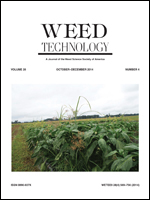Vinasse and biochar are by-products of biofuel production that can be used as sources of nutrients to crops or soil amendments to improve soil quality. Despite the recent interest in biochar and vinasse effects on soil properties, little is known about their effect on weed communities. We hypothesized that the addition of biochar and vinasse to the soil could affect weed seed germination and growth, and that different weed species would show different responses to these soil amendments. Therefore, the objectives of this study were to determine the effects of vinasse and biochar on the germination and growth of Palmer amaranth, sicklepod, and southern crabgrass. The study was conducted under laboratory and growth chamber conditions. Treatments consisted of four levels of vinasse (0, 10, 20, and 40 L m−2) and biochar (0, 0.5, 2.5, and 12.5 kg m−2) applied to a sandy loam soil. Biochar at 0.5 and 2.5 kg m−2 increased germination of Palmer amaranth but had no effect on sicklepod and southern crabgrass. Vinasse reduced germination of all species. However, sicklepod germination was less affected by vinasse at 10 and 20 L m−2 than the other two species. Vinasse at 40 L m−2 decreased Palmer amaranth, southern crabgrass and sicklepod germination 57, 26 and 87%, respectively. Biochar had no consistent effect on the vegetative growth of the species studied. Vinasse at 10 L m−2 stimulated growth of sicklepod and southern crabgrass compared to the nontreated control. Our results suggested that vinasse used as a soil amendment could affect weed community structure by decreasing germination of susceptible species, but plants and weed species that can get established in vinasse amended soils might show higher growth rates.
Nomenclature: Biochar; vinasse; Palmer amaranth, Amaranthus palmeri S. Wats, AMAPA; sicklepod, Senna obtusifolia (L.) H.S. Irwin & Barneby CASOB; southern crabgrass, Digitaria ciliaris (Retz) Koel DIGSP.
La vinaza y el biochar son subproductos de la producción de biocombustibles que pueden ser utilizados como fuentes de nutrientes para cultivos o como enmiendas para mejorar la calidad del suelo. A pesar del reciente interés en los efectos del biochar y la vinaza sobre las propiedades del suelo, es poca la información disponible sobre su efecto en las comunidades de malezas. Planteamos la hipótesis de que la adición de biochar o vinaza al suelo podría afectar la germinación y el crecimiento de malezas, y que la respuesta a estas enmiendas puede ser distinta dependiendo de la especie de malezas. Por lo tanto, los objetivos de este estudio fueron determinar los efectos de la vinaza y el biochar en la germinación y crecimiento de Amaranthus palmeri, Senna obtusifolia y Digitaria ciliaris. El estudio fue realizado en condiciones de laboratorio y cámara de crecimiento. Los tratamientos consistieron en cuatro niveles de vinaza (0, 10, 20, and 40 L m−2) y biochar (0, 0.5, 2.5, and 12.5 kg m−2) aplicados a un suelo franco arenoso. Biochar a 0.5 y 2.5 kg m−2 incrementó la germinación de A. palmeri, pero no tuvo efecto en S. obtusifolia ni en D. ciliaris. La vinaza redujo la germinación de todas las especies. Sin embargo, la germinación de S. obtusifolia fue menos afectada que las otras dos especies cuando se usó vinaza a 10 y 20 L m−2. Vinaza a 40 L m−2 redujo la germinación de A. palmeri, D. ciliaris and S. obtusifolia en 57, 26 and 87%, respectivamente. Biochar no tuvo un efecto consistente sobre el crecimiento vegetativo de las especies estudiadas. Vinaza a 10 L m−2 estimuló el crecimiento de S. obtusifo






